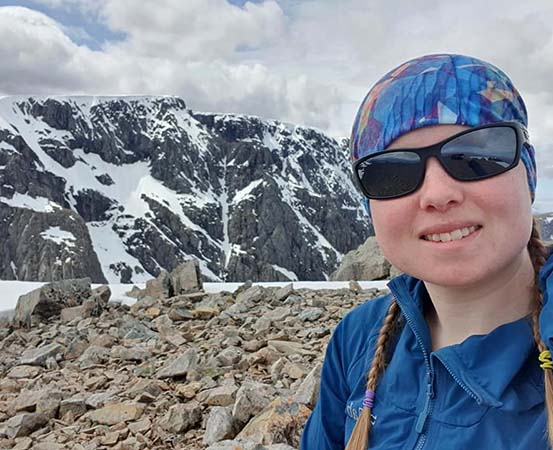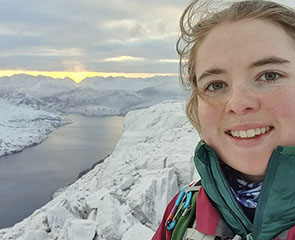
Diabetes could be life-altering but that shouldn’t stop anyone from scaling great heights in life, literally. People with diabetes could also go on treks and mountain climbing trips, albeit with proper planning and health precautions.
Scotland-based Ailsa Graham (27) used to accompany her family on treks to the local hillocks since her childhood and also went on to scale Mt Toubkal, the highest mountain in the Atlas mountains in her teens.
However, diabetes crept into her life at the age of 19 during a skiing vacation in Canada in 2014. She had to fly back home immediately as she came down with severe bouts of headaches, extreme tiredness, light-headedness, and balance problems. Initial tests revealed extreme blood glucose fluctuations forcing her doctor to put her on insulin. She was diagnosed with diabetes and further genetic testing revealed that she had a rare form of diabetes called Maturity-Onset Diabetes of the young (MODY).
Being an adrenaline and adventure junkie, she did not want to be bogged down by this diagnosis and started exploring the possibilities to manage her condition and also indulge in her passion for mountains. High altitude and blood sugar don’t gel well and often extreme precaution has to be taken especially against hypoglycaemia (low blood sugar).
“I started making sure that I have more carbohydrates before a trip to maintain good blood sugar levels. I learned to calculate and adjust my insulin dosage depending on the kind of hiking or climbing I plan to do on that day,” she adds
In 2021, she went ahead to be a certified mountain leader and a rock-climbing instructor. She has been an ardent hiker and mountaineer since then and has been on multiple treks and mountain trips in and around Scotland including Cairngorm national park in Scotland.
Zoya Narula, 25, an experienced trek leader says that it is important to understand that the body works differently for individuals with diabetes.
“So take regular breaks and also ensure that they carry easy-to-eat sugar-rich snacks to avoid any hypoglycaemic episodes,” she adds.

Tips for trekkers with diabetes
-
Pre-screening and doctor’s advice
Get your vitals and sugar levels checked before going on a trek. HBA1c, Kidney function test (KFT) especially creatinine are good indicators of an individual’s diabetic condition says Dr SM Fayaz, consultant-Internal Medicine, diabetology, Kinder Women’s Hospital and Fertility Centre, Bengaluru, India. He also points out that doctor’s advice should be sought before going on treks and high-altitude adventure trips.
-
Continuous or frequent blood sugar monitoring
Trekkers should opt for continuous blood glucose monitoring so as to avoid any chances of hypoglycaemic episodes during the trek. If Continuous Blood Glucose Monitor is not available then one should always check their blood sugar frequently and monitor it. It will also help to plan optimal insulin dosages for those with Type 1 Diabetes. Extremely low blood sugar fluctuations could lead to tremors, dizziness and palpitations.
-
Guzzle up fluids to avoid dehydration
Dr Fayaz cautioned that there are high chances of Dehydration because of the intensity of the physical activity. When there is a lack of water in the body it could lead to higher concentrations of blood glucose circulating in the body. Electrolyte fluids with benign sugar content or fruit juices could also help to avoid low blood sugar episodes during a trek.
-
Proper food intake
Erratic food timings accompanied by increased physical activity may create high chances of hypoglycaemia. So always ensure proper food intake and also have a few candies or sugar-rich easy-to-eat snacks for a quick sugar boost, if required.
-
Carry adequate diabetic supplies
Always ensure proper diabetic supplies including adequate insulin supply and other prescribed medications. If going on high-altitude climbs then carry backup insulin vials and syringes in case of the insulin pump malfunction due to weather and external factors. In case of high-altitude climbs, always carry a pulse oximeter also to check oxygenated blood levels frequently.
-
Always communicate about your diabetes with your trek team
Fellow trekkers or the trek leader should always be informed about your medical condition and diabetes so that they can respond properly in case of any emergency.
Takeaways
- Diabetes need not be an obstacle when it comes to hiking and high-altitude mountaineering.
- Ardent mountaineers and hikers point out that people with diabetes should always seek a doctor’s advice before going on a hiking trip. They should also ensure that they have adequate medical and diabetes supplies with them on the trip.
- Special precautions should be taken to avoid hypoglycaemic episodes at high altitudes by carrying carb-rich snacks and candies.
















